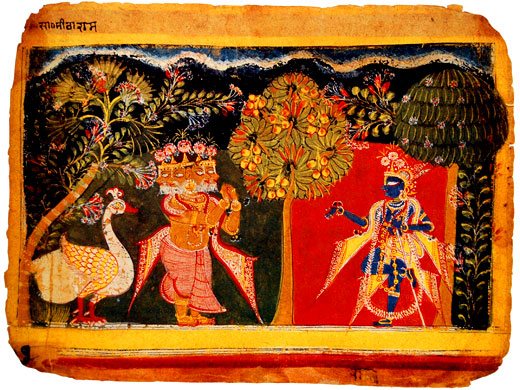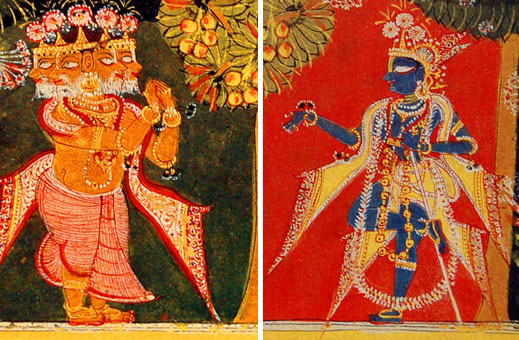
Those who, even while remaining situated in their established social positions, throw away the process of speculative knowledge and with their body, words and mind offer all respects to descriptions of your personality and activities, dedicating their lives to these narrations, which are sung by you personally and by your pure devotees, certainly conquer your Lordship, although you are otherwise unconquerable by anyone within the three worlds. (Lord Brahma’s Prayers to Lord Krishna, Srimad-bhagavatam 10.14.3)
Today I’ve posted a painting Brahma Honors Krishna and an excerpt from its commentary from the book Intimate Worlds: Indian Paintings from the Alvin O. Bellak Collection. The commentary, by art historian John Seyller, briefly tells the Brahma-vimohan lila (the pastime of the bewilderment of Brahma). Some nice details about the painting’s design are included.
The hearing of, and contemplation upon the lilas of Krishna, (especially as found in Srimad-bhagavatam) comprise what is widely considered an essential limb in the practice of bhakti-yoga. Over the next couple of weeks I’ll try to delve a little deeper into the Brahma-vimohan lila. Besides posting more art, I will be sharing some of Brahma’s prayers and my thoughts on them. There is much to discuss in terms of theology, Vedanta philosophy, yoga and rasa (in this context, an experience a particular relationship with God). I’ll be calling on some of The Bhakti Collective’s contributing writers to share insights and I invite readers to chime in as well.
Thanks.
Kaustubha das
Brahma Honors Krishna
Page from a dispersed series of the Bhagavata Purana
Northern India, probably Delhi-Agra region, c. 1525-40
Opaque watercolor and ink on paper
7 1/8 x 9 1/2 inches (18.1 x 24.1 cm)This painting, which falls at the beginning of the fourteenth chapter, marks the culmination of an episode that leads the god Brahma to acknowledge Krishna’s limitless existence. Having witnessed Krishna perform one supernatural feat after another, Brahma tests him once more, this time by employing magic to abduct a group of cowherds and their kine from Krishna’s presence. Krishna recognizes Brahma’s handiwork when he is unable to locate the missing cows and cowherds, and simple multiplies himself to replicate each one. The replacements resemble the original cows and cowherds in every detail, but they so strongly embody the divine presence that their mothers’ affection for them grows exponentially. This remarkable development and Brahma’s subsequent vision of each figure being transformed into Krishna in all his splendor move him first to marvel at Krishna’s ability to transcend his own deception and then to recognize the deity’s omnipresence with this, he dismounts his swan vehicle and prostrates himself before Krishna. Raising himself to his feet, Brahma joins his hands together in veneration, and begins a long hymn of praise to Krishna.
The artist pays tribute to the momentousness of the revelation by isolating each of the deities within a separate colored field. The stout, four-headed Brahma appears against a cool green background; Krishna, the object of his devotion stands opposite, his superiority indicated not only by his receptive gesture, but also by the brilliant red rectangle positioned immediately and exclusively behind him. Krishna’s theological advantage is carried through even to the trees that bracket and divide the two figures. Whereas Krishna stands erect on one leg between two trees with absolutely straight trunks, Brahma is backed by a date tree whose trunk bends close to him and his vehicle as if in imitation of his earlier prostration. A black sky and un undulating band of clouds set off the trees’ luxurious foliage and a flowering creeper, which entwine in the upper reaches of the composition to bind the two halves together. The result is a painting whose masterful design matches its religious eloquence. JS
